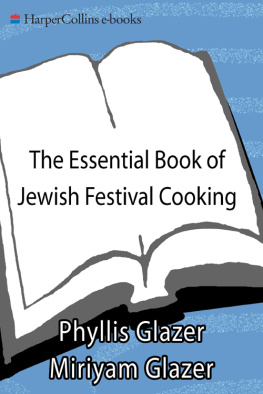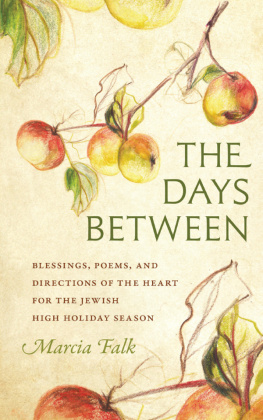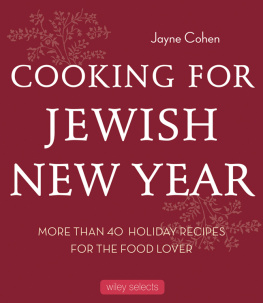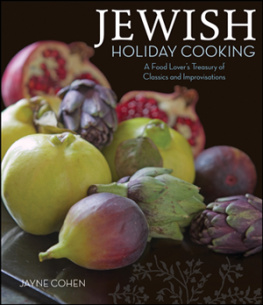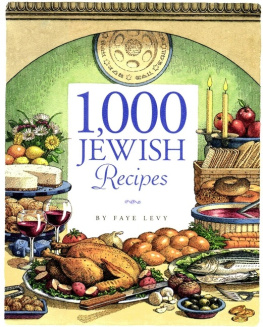The Essential Book of
Jewish Festival Cooking
200 Seasonal
Holiday Recipes
and Their Traditions
Phyllis Glazer with
Miriyam Glazer

We dedicate this book
to our mother,
Ida Glazer,
whose passion for cooking filled our lives with joy,
to Nissan Balaban,
who lit a spark that turned into a flame,
to our cherished daughters,
Avigail, Yarden, and Zohar,
and in loving memory of both our father,
Harry Glazer,
who always insisted that garlic and onions purify the blood,
and our grandmother
Rose Soroka,
whose modest kitchen started it all.
Contents
Long before timepieces and the Internet, our ancestors looked for agricultural signs to mark the passing of the seasons and the time for holiday rejoicing. Then as today, in the land of Israel, green garlic meant that Passover was near; the new barley and wheat harvests signaled the time for the Omer and then Shavuot; the vineyards with their ripened grapes was the setting for Tu bAv; the firm little yellow Barhi date was a tangible sign of the approaching Days of Awe, and olive oil was plentiful at Hanukkah. With the exception of Hanukkah and Purim, which arose in later eras, the festivalsin biblical daysresponded to the rhythms, seasons, and foodstuffs of the land.
But since ancient times Jews have lived mostly in exile. Uprooted from the earth of our ancestors in 70 C.E. after the Romans destroyed the Second Temple, our people could no longer see the blossoming of the almond tree in winter, summers profusion of white squill flowers, or the ripening of the wheat in spring. They could no longer bring their bikkurim, their first fruits, to offer to God in Jerusalem from late spring to early fall, from Shavuot to Sukkot, or sacrifice the Paschal Lamb at the Temple for Passover. The festival celebrations were forever changed.
But they scarcely disappeared. In the second century, the customs and laws of the holidays were collected in the Mishnah, and three centuries later, the detailed discussions about the Mishnah were in turn collected in the Babylonian and Jerusalem Talmuds (which we refer to as BT and JT in our book). Judaism survivedand flourishedin exile. With passion for protecting the legacy of the Jewish people, the rabbis of the Talmud evolved new meanings for each of the festivals to take the place of the Temple sacrifices, the tithing of the crops, and the agricultural symbolism that were part and parcel of our ancestors daily lives. They drew their sources from the Bible, from the teachings of their own forebears, the earliest rabbis in Palestine, and from the nations around them. The Judaism they developed has succeeded in surviving to this daythrough crusades, pogroms, and the Holocaust.
In an era like ours, which is actively reclaiming a true appreciation of nature and natural foods, understanding how the festivals began can awaken a fascination with the very same foods that nourished and inspired our ancestors, each in its own seasonand each with its own special significance. At the same time, Jews have a rich culinary heritage from our centuries in the vast Diaspora, from Morocco to Poland, from the Black Sea land of Georgia to Persia. As you turn the pages of The Essential Book of Jewish Festival Cooking, youll therefore discover recipes for the seasonal foods of the land that gave birth to the festivals to begin with, along with those developed by Jewish communities around the world.
Youll also find, possibly to your surprise, that unlike every other Jewish holiday cookbook, ours begins with the full-moon festival of Passover in the month of Nisan (March/April). Thats because Nisan, in the spring, was the first month in the Bible, the original beginning of the Hebrew calendar year. Autumns Rosh Hashanah emerged as the new year only during the Babylonian exile.
Join us as we wind our way through the seasons of the land of Israel, and the lands of the Diaspora, in what has been for us a spiritual, soulful, and, most of all, an exciting culinary journey into our roots.
Phyllis Glazer, Tel Aviv, Israel
Miriyam Glazer, Santa Monica, California
For now, the winter is past,
The rains are over and gone,
The blossoms have appeared in the land
The time of pruning has come
The green figs form on the fig tree,
The blossoming vines give off fragrance.
Song of Songs 2: 1113a
Passover
Zman Heiruteynu: The Season of Our Liberation
F rom the mountains of Nepal, where they may be trekking, to the 2,000-year-old Jewish community on the Tunisian isle of Djerba; from Buenos Aires to Southern California, a kind of homing instinct makes Jews all over the world seek out other Jews on the night of the fourteenth of the Hebrew month of Nisan (late March or April).
For thats the night of the Passover Seder, the first festival of the first month of the Jewish lunar year.
Maybe the homing instinct is a modern expression of the Passover pilgrimage of two millennia ago, when thousands of Jews from all over Israel flocked to the Temple in Jerusalem to celebrate the festival. In recent years, our own widespread family has joined together to hold the Seder at the shores of the Red Sea; in Tel Aviv, where our guests hailed from Colombia, Congo, Russia, and all over America; at our old family home on Rockaway Beach in New York; and even in Barcelona.
The way the Seder is conducted varies almost as much as its settings. Some of our friends chant the Haggadah, the ancient story of the liberation of the Israelites from slavery in Egypt, in the original Aramaic; others, along-side guests from across the racial and ethnic spectrum, relate it to contemporary issues of individual freedom or social justice. A family we know hangs sheets from the ceiling in their living room to make a tent, and the Seder participants lounge on pillows on the floor within it. Our own Ashkenazic family has adopted traditional Sephardic customs: The children dress as wayfaring Israelites at the outset of the Seder, and as we recite the Haggadahs description of slavery, we mimic the taskmasters of Egypt, gleefully beating each other with fresh green onions.
However and wherever the Seder is held, though, its symbolic foods, displayed on the Seder plate, include those laid down in the Talmud two thousand years ago: bitter herbsoriginally wild romaine lettuceto recall the harsh conditions the Israelites endured; haroset, to remind us of the mortar they had to form; and above all matzah, called lechem oni, the unleavened bread of poverty, but also the bread of freedom, for on the night the Israelites left Egypt, their sourdough starter, the yeast of biblical times, had had no time to rise.
Still, how startlingly different our celebrations are today from the first Passover described in the Bible or, generations later, held at the Temple. Ours comes from the Talmud, which evolved the rituals of the Seder based on the customs of Greek and Roman symposia in the centuries after the destruction of the Second Temple in 70 C.E.
But the Passover held on the night before the Hebrew slaves left Egypt, and, generations later, at the Temple in Jerusalem, was a true carnivores delight. Each clan was to slaughter a lamb, roast it, and then eat it entirely that night, along with bitter herbs and unleavened bread. On the verge of their liberation, the Hebrews in Egypt also took a bunch of hyssop, dipped it into the animals blood, and marked the doorposts and the lintels of their homes.

